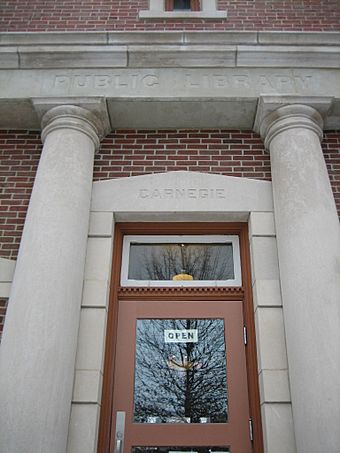Illinois Carnegie Libraries Multiple Property Submission facts for kids
Quick facts for kids |
|
|
Illinois Carnegie Libraries MPS
|
|

Buffalo Township Public Library in Polo, Illinois.
|
|
| Location | Illinois, USA |
|---|---|
| Built | Various |
| Architect | Normand Smith Patton, Grant Miller, Paul O. Moratz, William A. Otis, Pond and Pond, John Grant Beadle, Louis Ward Claude and Edward F. Starck, Clifford Shopbell. |
| Architectural style | Romanesque Revival, Classical Revival, Arts & Crafts |
| MPS | MPL015 - Illinois Carnegie Libraries Multiple Property Submission |
| NRHP reference No. | 64500205 |
| Added to NRHP | February 16, 1994 |
The Illinois Carnegie Libraries Multiple Property Submission is a special collection of buildings listed on the National Register of Historic Places in Illinois, USA. It was officially approved on February 16, 1994. This collection includes sixteen libraries in Illinois. Their construction was paid for by a very generous person named Andrew Carnegie in the early 1900s. All sixteen of these libraries were added to the National Register of Historic Places between 1978 and 2002.
Contents
Understanding Carnegie Libraries
Who Was Andrew Carnegie?
Andrew Carnegie was a very successful businessman. He made a lot of money and decided to give much of it away. He is known as a philanthropist, which means someone who gives money to help others. Carnegie donated about $40,000,000 to build libraries in the late 1800s and early 1900s. This was a huge amount of money back then!
How Libraries Changed America
Carnegie's donations were given as grants. Illinois received 106 of these grants, which was the third highest number in the entire country. Besides the 106 community libraries, he also funded four state university libraries in Illinois.
These Carnegie Libraries were very important. They show a big change in the history of American public libraries. People started to see libraries as a necessary part of every town. Libraries also began to change how society worked. Towns started using taxes to support their public libraries. Even the way libraries were designed began to change to fit new needs. In total, 1,679 libraries were built with help from Carnegie's funding across the world.
The History of Carnegie's Giving
Carnegie's Generous Donations
Between 1886 and 1919, Andrew Carnegie gave away $56 million worldwide for libraries. His giving can be split into two main periods. These are often called "retail" and "wholesale," based on how many libraries were built.
For the first ten years, from 1886 to 1896, Carnegie donated about $1,000,000. This money helped only six communities in the United States. It built a total of 14 library buildings. This time is called the "retail" period. During this time, his donations were limited to five towns in Pennsylvania: Pittsburgh, Allegheny, Johnstown, Braddock, and Homestead. He also helped one town in Iowa, Fairfield.
A New Way of Giving
As Carnegie moved from his "retail" to his "wholesale" period of funding, he changed his approach. Instead of giving money for large, multi-purpose buildings in big cities, he started to focus on smaller towns. He wanted to provide libraries to communities that might not have had many cultural places before his help.
Illinois Libraries and Carnegie's Help
Applying for a Library Grant
By the late 1880s, it was clear that Carnegie planned to give away much of his wealth. Communities, including those in Illinois, began to try and get these grants. Towns all over Illinois sent requests to Carnegie. From 1897, Carnegie had his personal secretary, James Bertram, handle these applications. Bertram was the person towns dealt with to get a library. He was known for being very efficient, even if he seemed a bit rude sometimes.
Libraries in the Submission
Even though Carnegie funded 106 libraries in Illinois, the Multiple Property Submission only included 17 of them. These libraries are found in small towns across the state. The libraries included in this special group are:
- Oregon Public Library
- Arcola Carnegie Public Library
- Ayer Public Library
- Buffalo Township Public Library (in Polo)
- Danville Public Library
- El Paso Public Library
- Greenville Public Library
- Havana Public Library
- Hoopeston Carnegie Public Library
- Jacksonville Public Library
- Lincoln Public Library
- Litchfield Public Library
- Olney Carnegie Library
- Paris Carnegie Public Library
- Paxton Carnegie Public Library
- Streator Public Library
- Vienna Public Library
Libraries Before Carnegie
Before Carnegie's libraries were built, many small towns in Illinois had poor library conditions. Letters sent to James Bertram asking for grants often described these problems. For example, in Oregon, Illinois, the Oregon Public Library had to use "undesirable rented rooms." It was first in a drug store and then in a bank building. The library in Havana, which had 12,000 books, was in a small room in city hall. It was crowded among other city offices. It's hard to know exactly how accurate these descriptions were, as towns wanted to win the grants. But these letters do give us an idea of what libraries were like before Carnegie's money arrived.
Other Illinois Carnegie Libraries
- Flagg Township Public Library
- Sycamore Public Library
- List of Carnegie libraries in Illinois

